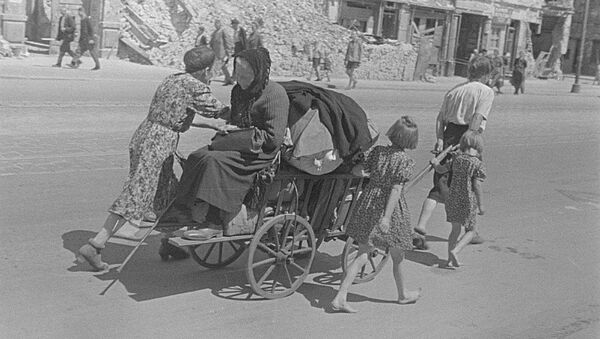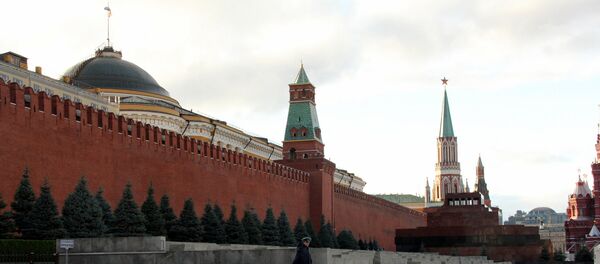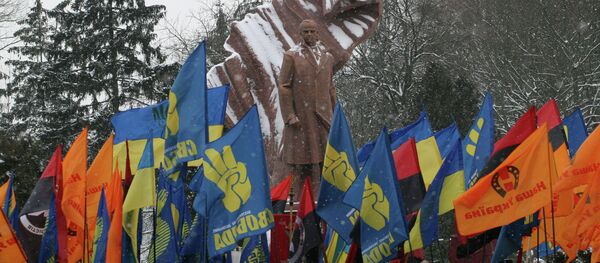In an article published recently in Czech magazine Literarni Noviny, historian Eva Hahnova challenges Western historiography's attempts to rewrite the story of the mass exodus of Germans from Eastern Europe at the close of the Second World War. The historian argues that while this event has been blamed on the marauding Soviet hordes, primary historical sources show that the exodus was actually carried out by German officials, and that the ineptitude and violence with which it was done constitutes the last massive crime committed by the Nazi regime.
Pejorative stereotypes about the Russian people in Western literature and journalism have a long and rich history, and are present in many interpretations of the past. Today the most striking example of this phenomenon is the contemporary interpretation of the Second World War. For example, when celebrating the 70th Anniversary of the liberation of Auschwitz, the Munich edition of the Suedetendeutsche Zeitung had a front page story about another anniversary.
The article, entitled "The Tragedy About Which We Must Never Forget: The Expulsion of 15 Million Germans Began 70 Years Ago," noted that as a result of the Soviet January offensive on Berlin, "women, children, and the elderly, alone or in groups, went West." The advancement of the Red Army, a harsh winter and the sinking by the Russians of ships with refugees in the Baltic Sea are said to have caused much suffering, and many did not survive. But equally terrible things, the article notes, awaited those who stayed behind and met face-to-face with Soviet soldiers, including the killing of civilians, mass rape of women and girls, as well as looting, arson, and deportation to forced labor camps in the USSR. Such a fate, the newspaper said, awaited Germans on the territories of present-day Poland, Hungary, Yugoslavia, and Romania, as well as the Sudeten Germans in Czechoslovakia. "The further east they lived, the more severe was the approaching revenge and retribution," the paper commented.
"What our people are experiencing today can be compared with the invasion of the Huns and the Mongols in bygone centuries," German newspaper Volkischer Beobachter wrote on January 25, 1945. A day later, the conversation turned to a "red plague advancing from the east toward German land." On February 10, readers were told of "murders, abuse, capture and deportation of people to forced labor, the destruction of all the fruits of generations of labor and the desecration of everything that gets in the way of the Bolshevik hordes."
All the 'Soviet atrocities' were held to have been "proven and thoroughly checked by testimony of witnesses," including the mass rape of women: "German women are being raped, and then killed together with women and the elderly, in the aims of exterminating our people." Famous writer Ilya Ehrenburg, who was referred to as the "Pet Jew of the Kremlin" in Nazi propaganda, was claimed to have cynically written about "the extermination of the Germans and other nations" as part of a Bolshevik plan to attack Europe.
Planned Rückführung
From an entry on March 1, 1945 in the diary of General Paul Freiherr von Schoenaich, we learn that "all the refugees from the east with whom I have spoken have told me that they were fleeing not voluntarily, but on order of the police. None of them believed that the Russians would do something to them. Only those who came from areas with a Polish population expected that the Poles would attack them, but they felt sure that they could defend themselves. From this it follows that eastern Germans no longer believe in Goebbels' lies about the horrors of the Bolsheviks." General Paul Freiherr von Schoenaich's assessment is confirmed by many [other] documents.
The so-called exodus was discussed in society and in Nazi propaganda. In the working jargon of the Nazi regime the terms "evacuation" or "return" (Rückführung) were used, when the reality was that fleeing individually and on one's own will was practically impossible: In fact it was forbidden and subject to punishment. Forced evacuation of the entire [German] population had in fact been planned since the spring of 1944, and the Germans began to carry out the process that summer. Archival documents tell us about its details. Moreover, detailed reports on the progress of the evacuation sent to Berlin by senior officials until the end of the war have been preserved. Among these materials, as well as the testimony of witnesses, we find that the evacuation led to a humanitarian catastrophe of an unprecedented scale.
The inhabitants of individual regions and cities were forced to leave their homes and to move in groups to unfamiliar regions without any infrastructure. Those who resisted were met with a variety of methods: sometimes they were blackmailed by propaganda; at other times their food rations were taken away; sometimes they were met by open violence. Notable are the reports of the no less chaotic flight of the demoralized sections of the Wehrmacht, who were documented to have mistreated civilians they met along the way. According to the last official figures of the Nazi regime from March 6, 1945, the evacuation had affected over 10 million civilians. But only on April 29, 1945 was a ban issued on violent coercion of the population as a means of getting them to evacuate their homes.
Mania of Destruction
The journals of the priest Paul Paikert from the period between January and March 1945 provide a detailed account of the evacuation of Wroclaw, Poland [then called Breslau]. In late 1944, 4.4 million Germans lived in Silesia; by the end of the war there were only 1.5 million left. In this way, Wroclaw turned into a desolate heap of ruins even before the arrival of Soviet troops. Paikert wrote in his diary almost every day about what he had seen around him, and what people had told him in conversations. On Easter he left the surrounded and burning city, returning there following the end of the war in order to transfer his diaries to the diocesan archive. Subsequently, his diaries were published in Poland and East Germany, but in West Germany, where Paikert spent the rest of his life, they are still unknown.
Paikert's journals inform us of propaganda and intimidation toward the population about the barbarous habits of the Red Army, and of people's mood, noting that they would very much like to see the Russians come and finally put an end to Nazi debauchery. The diaries speak about the brutality with which the Nazis forced children, women and the elderly out into the freezing cold to evacuate into the unknown. He notes that sometimes they even threatened to use firearms, and torched homes, so that people could not come back. "It's awful to see how people are coming back to their homes, looking to find and save something dear to their hearts. But our people have succumbed to a mania of destruction. Entire blocks of housing have been set on fire, and in a few days only bare walls are left." Hundreds of people died every day on the streets and ditches along the roads outside the city. Special teams collected their bodies and transported them to places unknown. "Yesterday I learned that during one such campaign over 400 corpses of children and adults were collected in a fairly short period of time. How many people died in the cold due to this flight we'll probably never know," Paikert wrote.
Hazy Past
Within the former Czechoslovakia, the inhabitants of Slovakia were the most severely affected. From the 130,000 Germans who lived there in the [early] 1940s, nearly all of them were evacuated between October 1944 and March 1945. Some had returned after the war, with 32,450 being deported and resettled in 1946. In Silesia and Moravia as well, the German population could not escape its cruel fate. According to historian Emily Grabovets, most Germans from Brno [Czech Republic] had fled or were evacuated prior to the arrival of the Red Army. "Their numbers and subsequent fate, however, remain unknown," she noted. The rural population, especially in South Moravia and Jihlava, also left their homes and marched in groups, most often to Austria.
In the so-called protectorate of Bohemia and Moravia, preparations for evacuation began in February 1945, but the importance of industrial production hampered plans. Only on April 19 did Sudeten German Minister of State Karl Hermann Frank, speaking of "the threat of the Red Army," note the priority of "conserving German genetic code, in our wives and children," and order them to be evacuated. But there was little time, and people left independently as best they could. Nazi Mayor of Prague Josef Pfitzner complained in his diary about the German refugees, "which came to the country from the old Reich, settled in spacious villas, furnished by the Jews," and who now showed that they did not have any real connection to the territories in which they lived.
The experiences of the Germans from Wroclaw and Prague were very different, which the common language of "flight and expulsion" blurs. The same applies to all 11 million Germans who lost their homes due to the war and arrived in the territory of contemporary Germany by various means; among them were the nearly 5 million Germans who came to Germany from Poland, Czechoslovakia and Hungary after the war. At the same time, this, the last mass crime of the Nazi regime, the forced evacuation of the German population, is hidden behind talk of the alleged barbarity of the Soviet Army in relation to the civilian population. This relic, an echo of Nazi propaganda, has nonetheless become a favorite subject in discussions of the past, even if it is a classic example of stereotypical overtones used as needed for a variety of political purposes.
The terms "Soviet Army," "Russians" or "Bolsheviks" are used interchangeably as synonyms, like the names Stalin and Putin. The phrases "threat from the East" and "Kremlin" continue to retain extreme popularity in politics and journalism, as demonstrated in today's problems in international relations. Just as a lack of information obscures perceptions about the end of the Second World War, so too do stories about the current threat from the Kremlin often, already at first glance, suffer from an obvious penchant for hollow phrases, rather than objective information and reasonable judgments.
Eva Hahnova is a German author of Czech origin, engaged in the study of the history of Central Europe and Czech-German relations in the 20th century. Her article, entitled "About the Anti-Russian Stereotype Based on Goebbels' Propaganda," was published earlier this month in the Czech political and cultural magazine Literarni Noviny.






